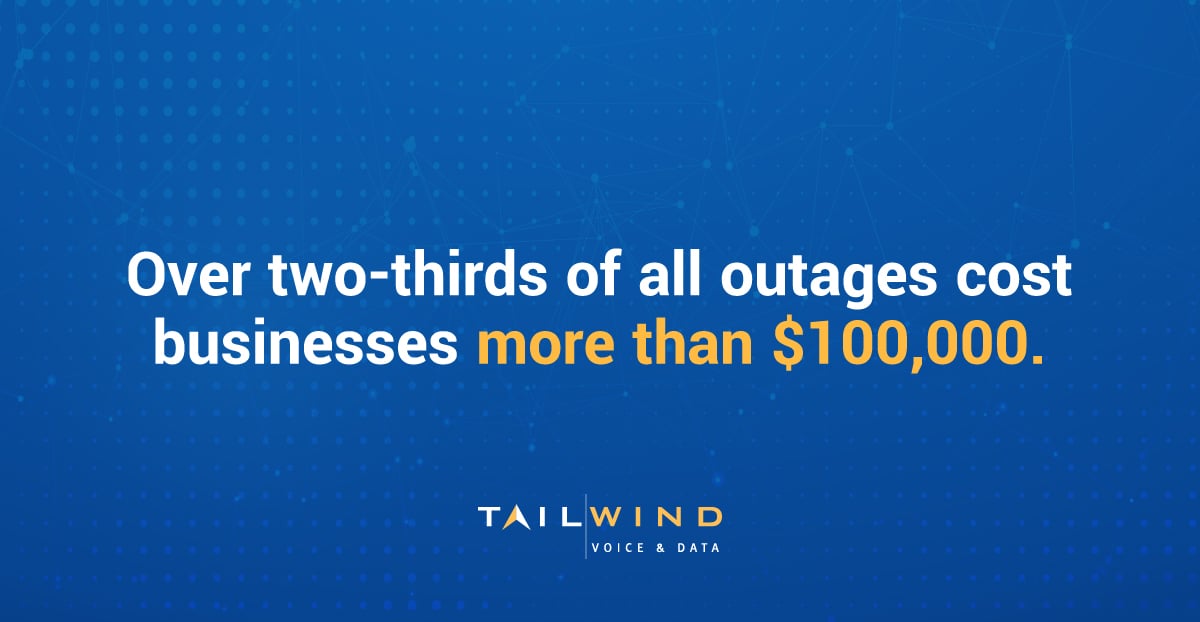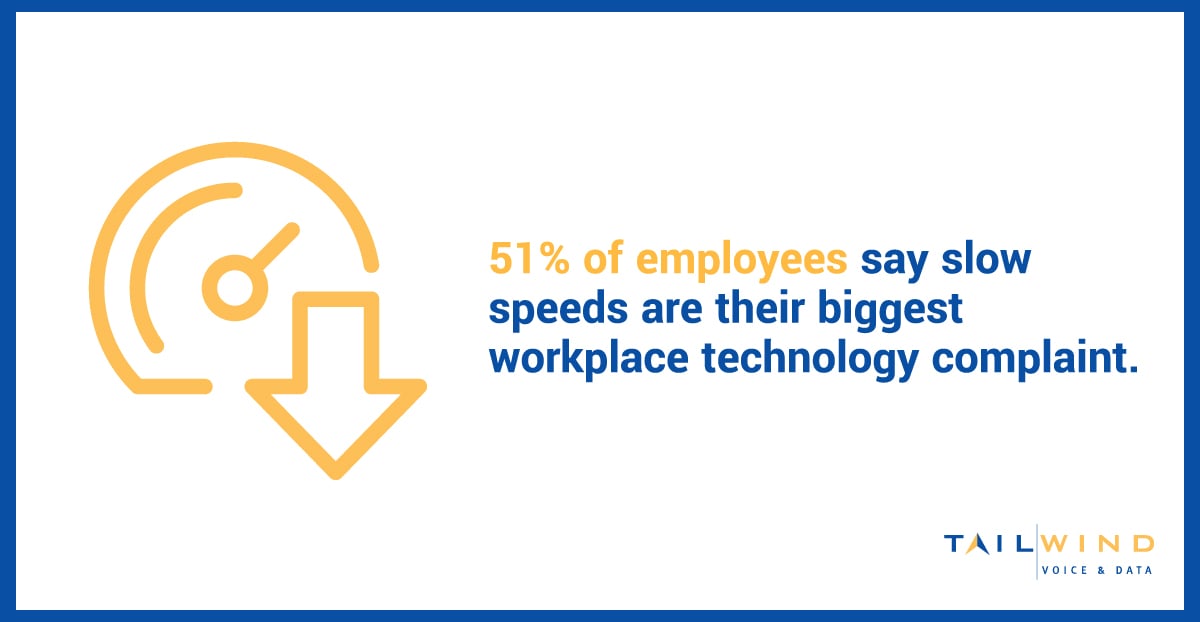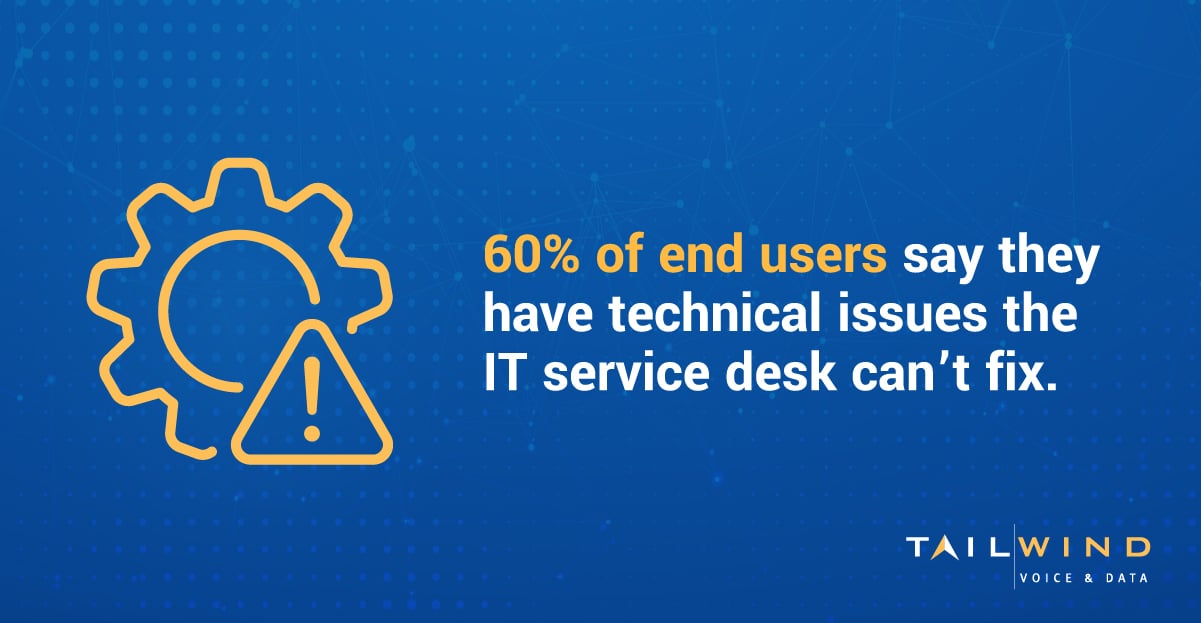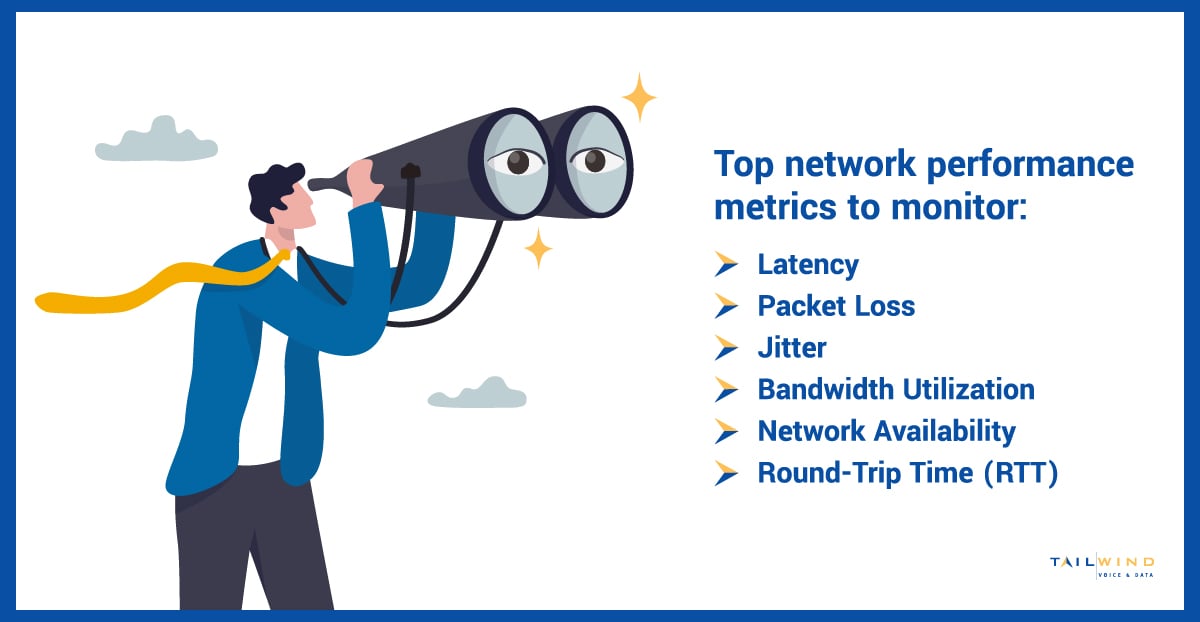With so many daily operations relying on technology, even minor network performance issues can have a huge impact on your organization's productivity, profits, and customer satisfaction. In 2023, 91% of global businesses experienced at least one outage quarterly.1 And with over two-thirds of all outages costing more than $100,000,2 measuring and monitoring network performance should be a top priority for organizations of all sizes.
In this comprehensive guide, we’ll walk you through the fundamentals of network performance monitoring, key network performance metrics to pay attention to, and what your business can do to optimize network performance.
What Are Network Performance Metrics?
Network metrics are quantitative measurements used to evaluate a network's speed, reliability, efficiency, and overall health. By collecting and analyzing metrics like bandwidth, latency, data packet loss, and uptime, IT teams can gain crucial insights into network performance problems.
These metrics act as numerical vital signs, indicating when networks are functioning normally and when potential issues arise. Just as a doctor reviews a patient's vital statistics like heart rate and blood pressure, network admins use metrics to diagnose problems and determine where improvements need to be made.
Monitoring key network metrics provides three main benefits for businesses:
- Visibility - Metrics uncover network behavior and utilization, enabling IT teams to see what's happening in their network infrastructure.
- Diagnostics - Unusual patterns or thresholds in metrics can indicate underlying network issues. Metrics help pinpoint exactly where problems originate.
- Optimization - By establishing network performance baselines and tracking metrics over time, teams can fine-tune for peak efficiency.

Why Are Network Performance Metrics Important?
Here are some reasons why it's important for businesses to measure network performance metrics:
Prevent Downtime With Proactive Monitoring
By closely following network performance metrics, IT teams can detect issues early before they snowball into outages. This prevents disruptions to business-critical processes and applications.
Improve Employee & Customer Experiences
Employees and customers expect fast, reliable network connections. 51% of employees say slow speeds are their biggest workplace technology complaint.3 Network performance monitoring metrics help ensure applications run smoothly, downloads are fast, and connections are stable.
Make Smarter Infrastructure Investments
Metrics analysis determines where network infrastructure needs improvement so IT staff can strategically invest in solutions that address identified weak spots.
Ensure SLA Compliance & Uptime Guarantees
SLAs can include metrics like uptime, latency, or data packet loss thresholds. Measuring network performance metrics helps verify IT services meet commitments.
Troubleshoot Faster With Accurate Diagnostics
Around 60% of end users say they have technical issues the IT service desk can’t fix.4 Network performance metrics pinpoint where and when problems occur, cutting down on lengthy network troubleshooting and ensuring services get back up faster.
Plan For Growth With Real-Time Data Insights
Historical network performance data forecasts future infrastructure needs as network demands increase, assisting capacity planning to support business growth.
What Is Network Performance Monitoring (NPM)?
Network Performance Monitoring (NPM) is the continuous process of measuring, analyzing, and optimizing the speed, reliability, and overall performance of a computer network. It helps detect issues like latency, packet loss, and bandwidth bottlenecks, ensuring efficient data flow across applications, devices, and services.
The Types Of Network Performance Monitoring
There are a few different types of network monitoring IT teams can leverage, including:
Performance Monitoring
Performance monitoring evaluates networks from an end-user perspective. These solutions enable network teams to measure network performance metrics like bandwidth, latency, and data packet loss to verify networks meet QoS and SLA requirements.
Fault Monitoring
Fault monitoring detects, tracks, and alerts when network devices and components fail, which helps restore services promptly before outages can impact users.
Security Monitoring
Security monitoring safeguards networks against cyber threats like malware, intrusions, and data breaches by analyzing network traffic patterns and system logs.
Configuration Monitoring
Configuration monitoring ensures network devices and systems are set up correctly, preventing misconfigurations from causing network performance issues or outages.
Log Monitoring
Abnormal activity in logs can signify problems. Log monitoring involves collecting and analyzing event logs and SNMP traps for visibility into network device operations.

What Is Network Performance?
Network performance refers to the overall quality and efficiency of a computer network, measured by key metrics such as speed, latency, bandwidth, uptime, packet loss, and jitter. It indicates how well data is transmitted across the network and directly affects user experience, system responsiveness, and application reliability.
What Factors Affect Network Performance?
Several factors shape network performance, including:
Use Historical Data For Network Analysis
Compiling performance data like response times, bandwidth usage, and uptime metrics enables historical analysis. The comparison identifies trends and deviations from normal operations.
Track KPIs With Real-Time Measurements
Actively monitoring throughput, latency, and other KPIs verifies that networks meet quantitative benchmarks for optimal performance.
Monitor How Users Experience Your Network
The end-user experience ultimately defines network performance. Monitoring network traffic and infrastructure health ensures users have responsive, consistent connectivity.
While components like routers, switches, and servers enable networks to function, network performance isn't about individual devices. Instead, it encompasses the overall ability to deliver applications and services to users with adequate speed and scalability.
How Can Businesses Measure Network Performance?
In order to measure network performance effectively, businesses need network monitoring tools that provide:
Network Visibility
Gain insight into all infrastructure and network traffic flows for accurate performance assessment.
Metrics Collection
Collecting network performance metrics across the infrastructure forms baselines to distinguish normal vs. suboptimal operations.
Analytics & Reporting
Analytics and reporting tools interpret network performance trends and drill down to specifics.
Alerting
Trigger alerts when network performance metrics veer from baseline thresholds to ensure IT teams can address issues proactively.
User Experience Simulation
With network performance metrics, IT staff can emulate user traffic to measure quality as end users see it.
These capabilities deliver the visibility and diagnostic capabilities needed to measure network performance, allowing network administrators to pinpoint developing issues and make data-driven decisions to optimize network architecture.
Types Of Network Performance Monitoring Tools
Not all network performance monitoring (NPM) tools work the same way. Broadly, they fall into two categories: flow-based monitoring tools and deep packet inspection (DPI) tools. Each type offers different levels of visibility and resource efficiency, making them suitable for different use cases.
Flow-Based Monitoring
Flow-based tools analyze traffic by evaluating flow records generated by routers and switches. A flow is a sequence of packets with shared attributes, such as source/destination IP and port.
Benefits of flow-based monitoring tools include:
- Scalability: Ideal for high-traffic environments since flows summarize large volumes of data.
- Network Visibility: Provide a big-picture view of how traffic moves through your network.
- Anomaly Detection: Help detect unusual traffic patterns that could signal issues.
- Lightweight Resource Use: Flow data is less intensive to process and store than full packet captures.
Deep Packet Inspection (DPI)
DPI tools examine each individual packet that traverses the network, including payload content and application-layer protocols.
Benefits of DPI tools include:
- Detailed Traffic Analysis: Reveal protocol-level information, URLs, and user activities.
- Advanced Troubleshooting: Offer packet-level insights for forensic investigations.
- Traffic Classification: Enable identification of specific applications and policy enforcement.
Choosing between flow-based and DPI tools, or deploying both, depends on your network size, performance goals, and the depth of visibility your team needs.

Best Practices For Network Performance Monitoring
To get the most out of your NPM strategy, it’s essential to follow a set of best practices that ensure effective, accurate monitoring across your infrastructure.
Here are 6 key best practices to follow:
- Define Clear Objectives: Align your NPM goals with overall IT performance and security requirements.
- Establish Baselines: Set normal performance thresholds for your network and update them regularly as usage evolves.
- Use Scalable Tools: Choose solutions that can handle your network’s scale and complexity without compromising on speed or accuracy.
- Ensure Proper Data Handling: Implement structured processes for collecting, storing, and analyzing network data.
- Monitor with Context: Go beyond raw metrics, focus on actionable insights that support both IT and business objectives.
- Stay Proactive: Conduct regular analysis and incident response exercises to detect and address issues before they escalate.
What To Look For In A Network Monitoring Tool
When selecting an NPM solution, it's important to evaluate how well the tool fits your environment and goals. From data capture to long-term storage, here are factors to consider:
Flow Compatibility
Do your devices support NetFlow, sFlow, or other flow formats? If not, DPI tools may be a better fit.
Data Sources
Know what data matters most (flow records, raw packets, logs) and make sure the tool supports it.
Strategic Monitoring Points
Start by monitoring key network areas like core switches or internet gateways for maximum impact.
Historical vs Real-Time Data
Some tools don’t retain historical data long-term. Be clear on what visibility you need and for how long.
Storage & Costs
Full packet capture can be expensive. Tools that extract and store just the relevant metadata can reduce cost without sacrificing insight.
Ease Of Use
Some DPI solutions require deep expertise. Look for tools that balance depth of insight with usability for your IT team.
12 Essential Network Performance Metrics To Monitor
Many network performance metrics provide insight into performance and health. Focusing on a select few core metrics prevents data overload while still equipping IT with what's needed to understand network operations, identify abnormal behavior, and make improvements.
Here are 12 key network performance metrics to guide your IT teams:
1. Latency
Latency, the time it takes for traffic data to get from point A to point B across a network, must be monitored because it directly impacts user experience. Consistently high latency leads to delays, lag, and buffering issues that result in network performance degradation. Tracking latency metrics helps set network performance baselines and reveal abnormal patterns. IT can then troubleshoot the root cause before latency disrupts critical apps.
2. Packet Loss
Packet loss occurs when network data packets fail to reach their intended destination. Just a small percentage of packet loss can seriously affect network efficiency. Packet loss forces data packets to be retransmitted, slowing overall network performance. Monitoring packet loss helps identify congested network segments, faulty devices, and configuration issues. It enables IT teams to address the sources of packet loss and maintain reliable data transmission across the infrastructure.
3. Network Jitter
Jitter refers to inconsistent packet transfer times over a network, resulting in increased or uneven latency. It can cause significant performance issues – including choppy audio, video buffering, and poor call quality – for real-time services like video conferencing that depend on steady packet delivery. By tracking network jitter metrics, IT teams can determine the severity of fluctuation and troubleshoot the root causes, such as configuration errors or network congestion.
4. Bandwidth Utilization
Tracking network bandwidth usage indicates the percentage of total bandwidth currently being consumed on a network. Spikes in network bandwidth usage can create congestion and slow traffic, but IT teams can set utilization thresholds and add capacity as needed. Monitoring available bandwidth also helps balance traffic across different network segments to use resources more efficiently.
5. Network Availability
Uptime metrics measure the percentage of time that network services and resources are accessible and operational for users. High network availability is essential for organizations delivering cloud services, online retail, banking systems, or other 24/7 operations. Comparing uptime to service level agreement (SLA) targets verifies networks meet mandated availability requirements.
6. Round-Trip Time (RTT)
Round-trip time (RTT) measures the total delay for a network request to make a complete round trip from sender to receiver and back. High round-trip time indicates potential issues like network congestion that are introducing delays. Monitoring round-trip time helps diagnose the root causes of latency and ensures networks have acceptable response times, which is critical for applications like VoIP and video conferencing.
7. Network Error Rate
Network error rate gauges the percentage of total data packets that contain errors or are corrupted during data transmission. Tracking network error rates helps identify issues like hardware failures, signal interference, or software bugs that are introducing errors into data packets, necessitating retransmissions and impacting performance.

8. Packet Loss Rate
The data packet loss rate measures the percentage of data packets lost during transmission over a specific timeframe. A high rate of lost data packets directly degrades network performance and must be minimized. Monitoring data packet loss rate helps determine if parts of the network suffer from chronic packet loss due to errors or congestion.
9. Data Transfer Rate
The data transfer rate, also known as network throughput, measures the rate of successful data transmission across a network. Slower than expected data transfer rates can indicate problems like network congestion, packet loss, overloaded servers, or other bottlenecks constraining network capacity. Monitoring data transmission speed helps compare network performance against bandwidth limits and identify scenarios where networks are operating below optimal speeds.
10. Mean Opinion Score (MOS)
MOS provides a numerical rating of call quality for audio transmissions over IP networks. It's typically used to measure VoIP call quality based on how end users would perceive it. Monitoring MOS helps ensure VoIP systems meet minimum standards for call clarity and reliability.
11. Network Congestion
Keeping congestion low is essential for avoiding network performance issues that frustrate end users. Network congestion happens when traffic volume exceeds available capacity, resulting in slowed network performance and lost data packets. Monitoring congestion levels helps IT teams visualize traffic patterns and utilization across different network segments. Identifying areas prone to high congestion enables implementing targeted fixes such as adding bandwidth, adjusting QoS settings, or load balancing to alleviate the strain on overloaded links and minimize future downtime.
12. TCP Retransmission Rate
Transmission Control Protocol (TCP) retransmission rate measures the percentage of TCP segments that had to be re-sent due to issues like network congestion or data packet loss. The Transmission Control Protocol ensures reliable data transfer by retransmitting lost data packets. However, high TCP retransmission rates can indicate underlying network problems that should be addressed. Monitoring this metric helps identify congestion, data packet loss, and other connectivity issues that are forcing TCP retransmissions.
Boost Your Network Performance Monitoring With Tailwind's NOCaaS
High-performing networks are essential for maintaining business services, keeping users connected, and enabling company growth in today's digitally driven world. However, increasingly complex network architecture can make it difficult for organizations to monitor network performance effectively, resulting in issues that frustrate employees and customers alike.
TailWind's complete NOCaaS solution provides ongoing support from our U.S.-based team of experts who oversee your business's network performance and troubleshoot issues. Plus, we offer a proactive network performance monitoring system via SolarWinds® customized to fit your processes so you gain 24/7 insight and expertise to optimize your network.
SolarWinds® network performance monitoring tools offer:
- End-to-end visibility across your network
- A clear view of performance metrics for troubleshooting
- Detailed metrics analysis to identify root causes
- Intelligent alerts for faster responses
- Wired and wireless device monitoring
Our NOC specialists can partner with your IT teams to assess your infrastructure, implement the right network monitoring tools, and help manage networks seamlessly so you can focus on meeting critical business goals. Reach out to TailWind today to discuss how our NOCaaS solution can elevate your network performance.
Sources:
- https://www.digi.com/company/press-releases/2023/only-9-percent-of-organizations-avoid-outages
- https://uptimeinstitute.com/resources/research-and-reports/annual-outage-analysis-2023
- https://venturebeat.com/enterprise-analytics/report-91-of-employees-say-theyre-frustrated-with-workplace-tech
- https://www.forrester.com/blogs/despite-it-heroics-technology-is-systematically-failing-employees


